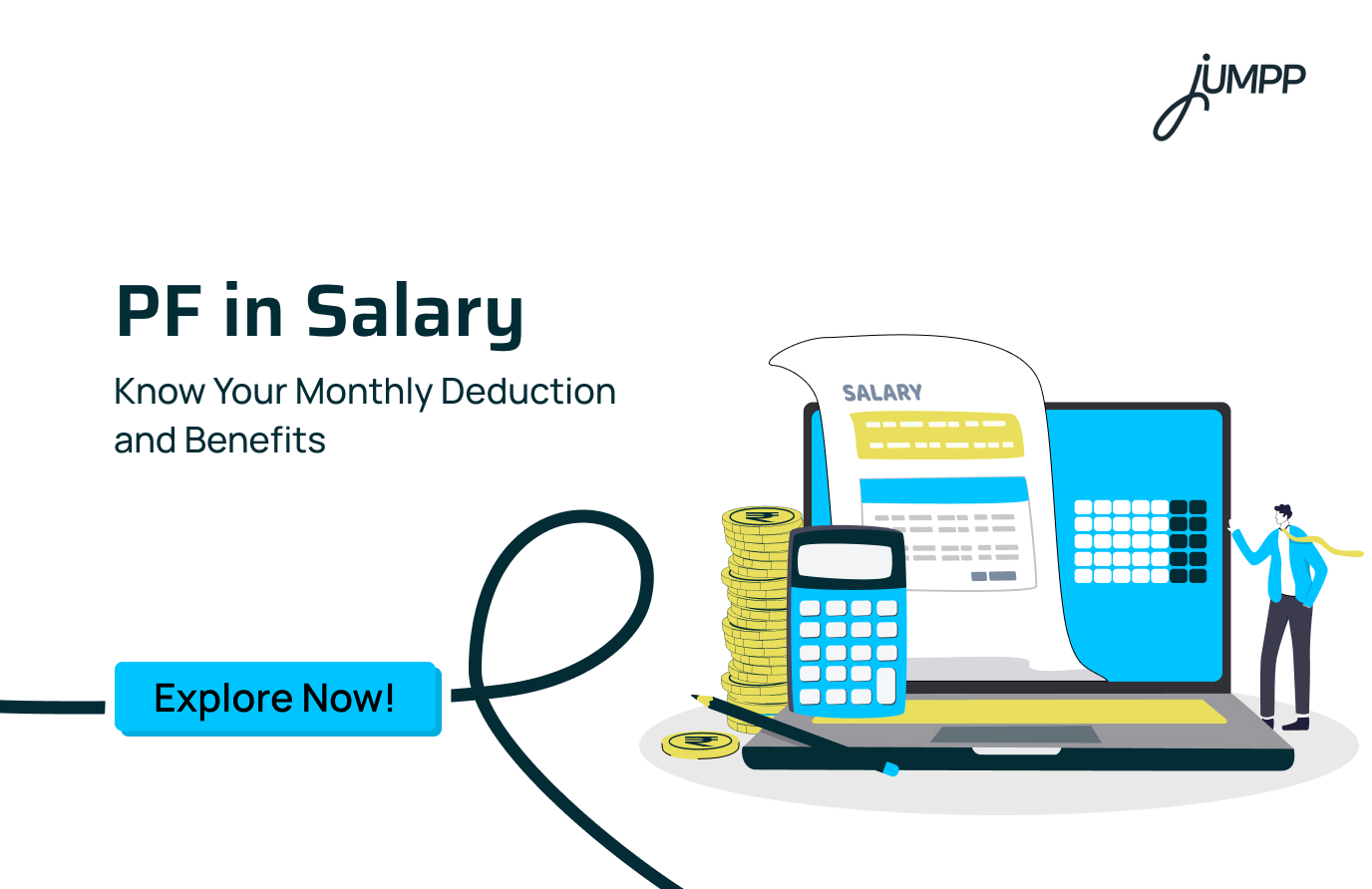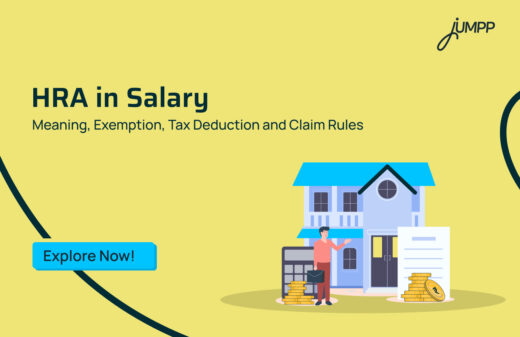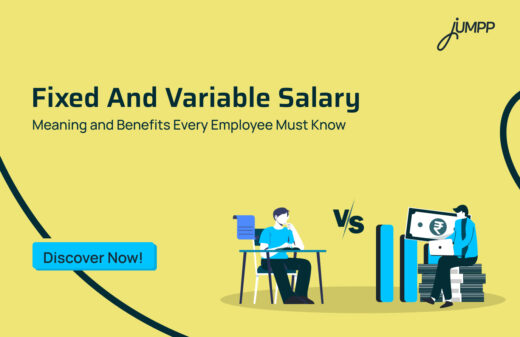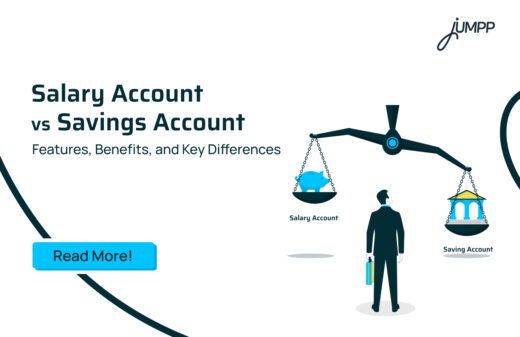What is PF in Salary? Types, Contributions, and Eligibility

You’ve been working for years, spending, and saving a little. Your company deducts PF too. Have you ever taken a moment to realise what PF deduction from your salary means? It actually refers to the monthly deduction from an employee’s basic salary plus dearness allowance (DA) towards their Provident Fund account, along with an equal contribution by the employer.
PF is a disciplined way to save for retirement, enjoy tax benefits, and secure financial stability for the long term.
Let’s dive into what PF is, its types, benefits, eligibility, deductions, and how it is calculated in the salary structure.
What is PF in Salary?
PF full form is Provident Fund. It is a mandatory retirement savings scheme for salaried employees that ensures a lump sum corpus at the time of retirement.
Both the employee and the employer contribute 12% each of the employee’s basic salary plus dearness allowance every month. Out of the employer’s 12% share, 8.33% goes into the Employees’ Pension Scheme (EPS) and the balance is credited to the employee’s Provident Fund account.
PF Deduction Percentage & PF Percentage in Salary
- Employee contribution: 12% of basic + DA.
- Employer contribution: 12% of basic + DA (8.33% goes to Employee Pension Scheme; remaining to EPF).
- Wage ceiling of ₹15,000 applies; contributions above this limit follow the ceiling.
- Sometimes temporary reductions occur (e.g., from 12% to 10%) as per government notifications.
PF is calculated on your basic pay plus DA—find out what “basic pay” really means in your salary.
PF/ EPF Eligibility 2025
- You must work in an organisation with 20+ employees.
- Your basic salary + DA should be ₹15,000 or more per month.
- Your age should be 18–54 years.
Your enrollment is automatic if the criteria are met. PF Calculation Example
PF Calculation Example
Suppose an employee’s basic + DA = ₹25,000:
- Employee contributes: 12% × 25,000 = ₹3,000
- Employer contributes: 12% × 25,000 = ₹3,000 (₹1,250 to pension, ₹1,750 to PF)
- Total monthly PF addition = ₹3,000 (employee) + ₹1,750 (employer) = ₹4,750
- Interest accrues yearly (around 8.15%) on the cumulative balance.
What are the Types of PFs in India
In India, the term Provident Fund (PF) is not limited to one scheme. It is an umbrella that covers several government-backed, long-term savings plans, each created for a specific group of people.
While the Employees’ Provident Fund (EPF) is the most widely known among salaried individuals, there are other forms like Public Provident Fund (PPF), General Provident Fund (GPF), and Voluntary Provident Fund (VPF).
1. Employees’ Provident Fund (EPF)
It is a mandatory scheme for employees in organisations with 20 or more staff. Both the employer and the employee contribute 12% of the basic salary + dearness allowance.
EPF is managed by the Employees’ Provident Fund Organisation (EPFO).
2. Public Provident Fund (PPF)
It is open to every resident Indian, salaried or self-employed. You need to make contributions of a minimum of ₹500 and a maximum ₹1.5 lakh annually. Payments can be lump sum or in instalments.
It has a 15-year lock-in, extendable in 5-year blocks. It enjoys full EEE tax status.
3. General Provident Fund (GPF)
This is exclusively for central and state government staff. The contribution amount ranges from 6% to 100% of basic salary. It is paid out on retirement.
Employees who joined the government service after 1 January 2004 are under NPS, not GPF.
4. Voluntary Provident Fund (VPF)
This is an extension of EPF for those who wish to save more. An employee can add up to 100% of their basic salary + DA. Employer does not contribute.
5. Other Types of PF in salary
- Recognised Provident Fund (RPF): Approved by the Income Tax Commissioner, usually in private organisations with 20+ employees.
- Statutory Provident Fund (SPF): For government institutions, universities, and educational organisations under the Provident Funds Act, 1925.
- Special PF Schemes: Certain industries like coal mining and shipping have their own provident fund frameworks.
Which PF type is deducted from a salary?
For a salaried employee, the most common deduction is the Employees’ Provident Fund (EPF), which includes both the employee’s mandatory contribution and a portion of the employer’s share.
If an employee opts to increase their contribution voluntarily, it is recorded under the Voluntary Provident Fund (VPF), and this additional amount is also deducted directly from their salary.
What are the Advantages of PF (EPF) in Salary
1. Guaranteed Employer Contribution – Employers match the employee’s contribution (12% of basic salary + DA), effectively doubling savings.
2. Long-Term Savings with Strong Returns – Government-backed, with competitive interest rates and the power of compounding, EPF builds a sizable retirement fund.
3. Comprehensive Tax Benefits – It falls under the EEE category. Herein, the contributions are deductible under Section 80C, and the interest, as well as withdrawals, remain tax-free (after 5 years of service).
4. Pension and Insurance Cover – This is the part of the employer’s contribution funds, EPS (lifelong pension) and EDLI (life insurance), adding extra layers of security.
5. Emergency Support – Partial withdrawals allowed for medical needs, home purchase, or marriage; unemployment withdrawals permitted up to the full balance.
What are the Disadvantages of PF (EPF) in Salary
1. Limited Liquidity – Funds are locked for retirement with strict withdrawal rules and penalties for premature use.
2. Restricted Investment Choice – Conservative allocations mean lower returns compared to equities or other high-growth options.
3. Reduced Take-Home Pay – A mandatory 12% monthly deduction lowers disposable income. Some employees, especially younger ones, may perceive this as a burden.
4. Taxation on High Contributions – Contributions above ₹2.5 lakh a year attract taxable interest.
5. Employer Dependency – Smooth handling of PF depends on timely deposits and accurate paperwork by employers, leaving room for delays or errors.
Thinking beyond PF? Discover how to grow your wealth smarter — explore our detailed guide on Bonds vs Stocks: Which is Better for You?
What is the Difference Between EPF and PPF
On the surface, both are long-term, government-backed savings schemes that encourage discipline and promise safe returns. But in reality, they serve very different audiences and have very different rules.
If you are salaried, your EPF is tied to your job and your employer. If you are self-employed or simply want to build a safe savings cushion, PPF is where you look.
Comparison of EPF vs PPF
| Feature | Employees’ Provident Fund (EPF) | Public Provident Fund (PPF) |
| Eligibility | Mandatory for salaried employees in organisations with 20+ staff. Automatic for those earning up to ₹15,000/month basic + DA. Voluntary above this with employer consent. | Open to all resident Indian citizens—salaried, self-employed, and even retired individuals. NRIs and HUFs cannot open new accounts. |
| Contributions | Employee contributes 12% of basic + DA. Employer matches this, with 8.33% diverted to the Employee Pension Scheme (EPS). | Voluntary contributions only. Minimum ₹500/year, maximum ₹1.5 lakh/year. |
| Interest Rate | 8.25%. | 7.1%. |
| Lock-in Period | Linked to employment. Transferable between employers. | 15-year lock-in, extendable in 5-year blocks. |
| Withdrawals | Partial allowed for medical, unemployment, marriage, etc. Full withdrawal at retirement. Withdrawals before 5 years are taxable. | Partial allowance from the 7th year, within limits. Full withdrawal only at maturity (15 years). |
| Managed By | Employees’ Provident Fund Organisation (EPFO). | Government of India directly. |
Pre-approved loans up to ₹51,000, collateral-free and ready in just a few clicks—get started today with the best personal loan app!
Conclusion
The employer’s matching contribution, government-backed interest, tax exemptions, pension support, and even life insurance coverage make PF one of the most valuable parts of a salaried employee’s compensation package.
PF in Salary Percentage- FAQs
EPF is usually 12% of your basic salary plus dearness allowance, with a matching employer contribution split between EPF and EPS.
On a full basic+DA of ₹35,000, the employee contribution at 12% is ₹4,200 per month. Employer contributions may differ due to EPS caps.
Employee PF at 12% of basic+DA would be ₹7,200, though employer contributions are often limited by statutory ceilings and company policies.
Currently, the statutory wage ceiling is ₹15,000 per month, but proposals for an increase to ₹21,000 are under consideration and awaiting official notification.
Payrolls often cap employee contributions to 12% of ₹15,000, the statutory wage ceiling. Even if your basic is higher, the deduction shows ₹1,800 unless you opt for Voluntary PF (VPF).
Full EPF withdrawal is allowed after leaving employment, subject to waiting periods. EPS has separate pension rules. Partial advances are allowed for emergencies or specific needs.
For EPF, the contribution base is basic salary plus dearness allowance (and retaining allowance where applicable). Most other allowances are excluded.
Source– epfindia.gov.in






